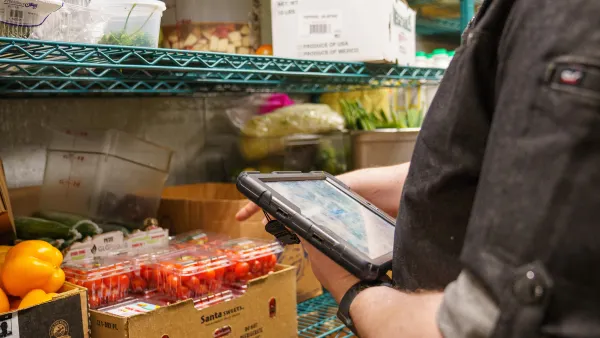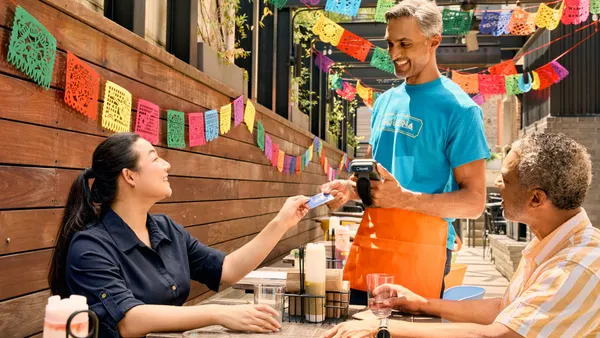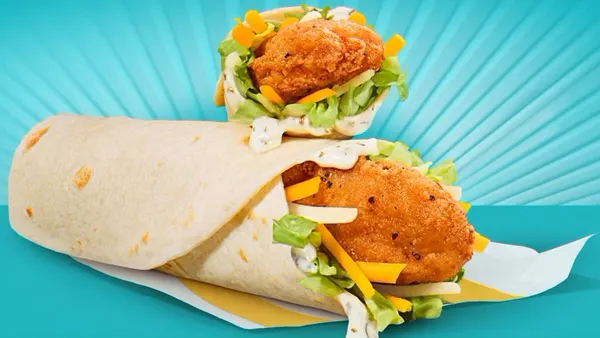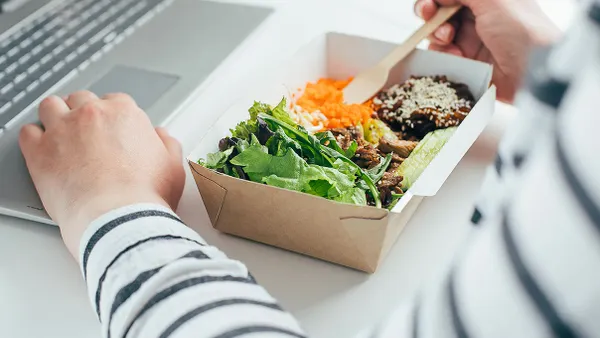Born into the Great Recession and a restaurant segment crowded with powerful legacy brands, MOD Pizza's rapid climb to leader of top-your-own pizza chains was unlikely, and continues to impress.
The Seattle-based chain, which launched in 2008, has leveraged savvy tech investments and off-premise optimization to win a hefty — and growing — slice of market share. MOD has been named the fastest-growing restaurant brand in the U.S. by Technomic for four years in a row. Last year, MOD's sales grew 45% to nearly $400 million and it boosted its store count by 34%, adding another 102 stores to its portfolio.
The chain plans to ramp its restaurant footprint to 1,000 locations in the next five years with $160 million equity financing led by Clayton, Dublier & Rice. MOD opens between 80 and 100 stores per year, and around 80% of those restaurants are company-owned, a capital intensive strategy buoyed by shareholder funding, MOD CEO Scott Svenson told Restaurant Dive.
"When you go into [restaurant] markets you have to have a commitment to being that first mover and market share leader," Svenson said. "It has paid dividends … but you have to moderate that fast pace of growth with continuing to elevate the quality of your execution. It's not just about getting bigger, you have to be equally committed to getting better."
The recent cash infusion will also help strengthen digital ordering channels, which have experienced 100% growth throughout the past year.
"The vast majority of our sales are coming from experiences customers have in-store with us, [but] an increasing percentage of those are coming through various digital channels, whether it's our website, mobile app or call center," Svenson said. "Many of those [channels] still lead to customers coming into the store to pick up their food or dine in."
MOD is marrying this focus on omnichannel opportunity with off-premise expansion. The chain, which opened its first drive-thru last year, has two drive-thru locations in its system and several more in the pipeline that will open in the next four months, Svenson said. MOD is also testing two digital pickup windows and designing new shelving to accommodate digital pickup orders.
"We're trying to figure out how to execute a drive-thru so that we can deliver a fantastic customer experience," Svenson said. "I would say right now it's really in a test and learn phase."
Investments in off-premise technology will be necessary for continued scale in a segment dominated by Domino's, which leads U.S. pizza chains in efficiency-focused technologies, Euromonitor analyst Miranda Lambert told Restaurant Dive.
"You have to moderate that fast pace of growth with continuing to elevate the quality of your execution. It's not just about getting bigger, you have to be equally committed to getting better.”

Scott Svenson
CEO, MOD Pizza
"Anyone who's even indirectly comparable to Domino's has got to be on top of their game, because even if it's not a great pizza … having it delivered to me by autonomous vehicle is going to make me want to do it," Lambert said. "You really have to be on top of your tech game if you want to be considered as a threat to Domino's at all."
Domino’s recently added in-car ordering and block-chain based AI to its arsenal, and Pizza Hut began piloting delivery bots with Fed Ex earlier this year, reflecting the pizza race's shift toward cutting-edge tech to get ahead.
Top-your-own pizza competitor Blaze Pizza is also a threat since it's pursuing an IPO within the next two years. Like MOD, the Lebron James-backed chain plans to rapidly expand its store count and bolster its delivery and takeout options.
The question for MOD, and its competitors, is if it will be in competition with all restaurants thanks to the accessibility of third-party platforms, Lambert said.
"I definitely don't know that there's room for much more competition," Lambert said.
But MOD's exclusive, nationwide partnership with DoorDash, which began in September, could help level the playing field with more experienced rivals and push past nimble newcomers. Still, this channel will be accretive to the in-store experience, Svenson said, which is the core of the brand's value proposition and helps the chain make a lasting mark in local communities.
"People are seeking convenience, and with convenience comes delivery," Svenson said. "But people still want to get out, they want to interact, they want to have human connection and a sense of community and that is what MOD is there to provide."



 Read more
Read more








